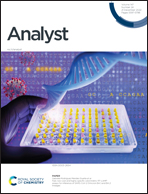Sulfur and nitrogen served as electron donors to rescue short wave emission or fluorescence quenching caused by nucleophilic addition†
Abstract
SO2 is not only a new potential gas signaling molecule, but also an antioxidant and antioxidant metabolite, which plays an important role in biophysiological and pathological processes. However, excessive intake of it can lead to serious complications of various diseases. Indole–iodide conjugated double bonds are often used as a sensitive response site for SO2, but the fluorescence of the system is often quenched after the nucleophilic addition of SO2. In this work, we introduced sulfur and nitrogen electron donors into a fluorophore, which rescued the trend of fluorescence quenching and enabled the system to develop a ratiometric fluorescence response for more accurate detection of SO32−. In addition, this probe can target mitochondria. The probe has good selectivity, sensitivity, a fast response (200 s) and a limit of detection (LOD) of 0.17 μM. Furthermore, the probe was successfully applied to visualize both endogenous and exogenous SO32− in Hela cells and zebrafish.

- This article is part of the themed collection: Analyst HOT Articles 2022


 Please wait while we load your content...
Please wait while we load your content...